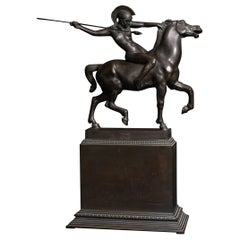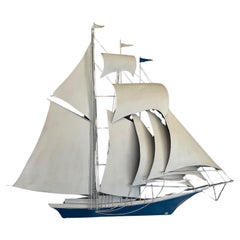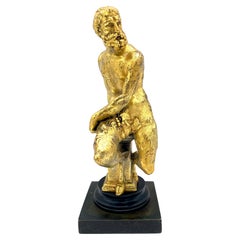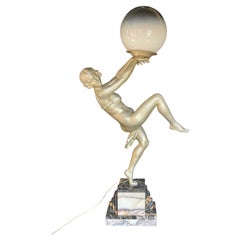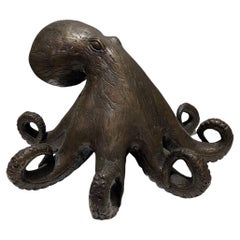Metal Figurative Sculptures
to
1,225
6,202
782
253
213
2,052
3,937
1,035
1,180
1,189
899
158
66
274
194
101
227
193
286
160
132
840
703
426
307
235
131
109
86
68
45
38
32
30
23
22
17
14
5
7,237
4,496
3,895
3,531
2,870
3,419
3,121
4,791
2,313
966
921
765
Height
to
Width
to
7,237
6,683
6,930
105
60
50
48
39
Material: Metal
Art Nouveau "Mounted Amazon" bronze sculpture by Franz von Stuck
Located in Chicago, US
FRANZ VON STUCK (German, 1863-1928) There is a tension between the Apollonian and Dionysian in Stuck’s work. Nietzsche’s contemporary and a kindred spirit, Stuck valiantly searched f...
Category
Early 1900s German Jugendstil Antique Metal Figurative Sculptures
Materials
Bronze
Austrian Bronze Sculpture by Franz Bergman
Located in Los Angeles, CA
Cold painted Austrian bronze sculpture by Franz Bergman depicting a carpet trader.
The piece shows great attention to detail and craftsm...
Category
1950s Austrian Moorish Vintage Metal Figurative Sculptures
Materials
Bronze
Large Vintage Sailing Boat Wall Sculpture by Wiley
Located in San Diego, CA
Mid-Century metal wall sculpture signed by artist Wiley. Beautiful design that floats majestically with easy and simplicity. The sculpture is light to the eye while complex in design...
Category
1970s American Mid-Century Modern Vintage Metal Figurative Sculptures
Materials
Metal
$1,160 Sale Price
20% Off
19th Century French Ormolu & Patinated Bronze Sculpture of a Seated Satyr
Located in West Palm Beach, FL
19th Century French Ormolu & Patinated Bronze Sculpture of a Seated Satyr
France, Circa 1875
A good quality 19th Century French Ormolu & Patinated Bronze Sculpture of a Seated Saty...
Category
19th Century Antique Metal Figurative Sculptures
Materials
Bronze, Ormolu
$760 Sale Price
20% Off
Art Deco Sculpture Signed Carlier
Located in NANTES, FR
Large art deco illuminating sculpture, circa 1930.
Spelter sculpture on marble base.
Opalescent glass ball soap bubble.
In perfect condition and electrified
Length: 17,5 cm
Diam...
Category
Mid-20th Century French Art Deco Metal Figurative Sculptures
Materials
Marble, Spelter
Cast Bronze Octopus Sculpture
Located in Jimbaran, Bali
A wonderful example of a hollow-cast bronze octopus. This piece features wonderful detail and resemblance to a real specimen. An exotic piece certain to...
Category
21st Century and Contemporary Indonesian Modern Metal Figurative Sculptures
Materials
Bronze
$1,200 / item
Art Deco Male Sculpture, Spelter, Marble, France circa 1930
Located in Regensburg, DE
Elegant Art Deco sculpture of an athletic scouting / watching male figure by Jean de Roncourt from France around 1930.
Very good original condition, greenish patinated Spelter / Zinc...
Category
1930s French Art Deco Vintage Metal Figurative Sculptures
Materials
Marble, Bronze
Midcentury Wood Monk Table Lamp Attibuted to Aldo Tura for Macabo, Italy 1950s
Located in Rome, IT
Midcentury amazing sculpture table lamp in wood and metal attributed to Aldo Tura for Macabo.
Made in Italy in the 1950s.
It depicts a bearded monk holding a stick (removable) in ...
Category
1950s Italian Mid-Century Modern Vintage Metal Figurative Sculptures
Materials
Metal
Etruscan Bronze Statuette of Discus Thrower
Located in London, GB
A remarkably fine example of Archaic sculpture. A figure of a discophoros, or discus bearer, standing with his right leg forward, gripping a discus in his right hand, the left arm raised with an open palm. Described with admiration in Münzen und Medaillen's 1961 auction, "The figure is a masterpiece and illustrates with rare vividness the essence of good Etruscan sculpture...
Category
15th Century and Earlier Antique Metal Figurative Sculptures
Materials
Bronze
Table Top Sculpture by Anne Van Kleeck in Bronze
Located in St.Petersburg, FL
A unique Anne Van Kleeck bronze, table top sculpture of abstracted figures, dancers perhaps. From the artist's estate. A note about the artist: Anne Van Kleeck was primarily known for her works in cast bronze and ceramics. She attended Ohio Wesleyan University (B.A.) and Ohio State University (M.A.) and spent several years as a professor of art in Ohio and Florida. In 1957, Anne traveled to Venice, Italy to study bronze and lost wax casting, beaten iron and mosaic techniques. During that stay she employed an Italian foundry expert and together they established a small foundry on the island of Murano where they cast bronzes for her one woman show in Venice. Van Kleecks work has won multiple awards and is owned worldwide by private collectors and museums, including the Metropolitan Museum and MOMA in New York. She was contemporaries of and exhibited with Ruth Asawa, Gary Knox Bennett...
Category
1960s American Mid-Century Modern Vintage Metal Figurative Sculptures
Materials
Bronze
20th C. Art Deco Style Clarte Lumina Standing Nude Sculpture Lamp 33.5"
Located in Germantown, MD
An impressive 20th Century Art Deco Style Clarte Lumina Standing Nude Sculpture and Table Lamp.
Measures 20" in width, 12" in depth and stands 31.5 " in tall. Marble base is 12" in...
Category
20th Century American Art Deco Metal Figurative Sculptures
Materials
Marble, Spelter
$2,765 Sale Price
30% Off
8 Foot Tall Pop Art Wood Pencil, 1970s USA
Located in Los Angeles, CA
Back to the drawing board! A remarkable piece for spurring conversation at home or for capturing attention in a store display. This massive vintage trompe l'oeil pencil is made of on...
Category
1970s American Vintage Metal Figurative Sculptures
Materials
Metal
Brass Lying Deer with Shamanic Inlays
Located in Marcq-en-Barœul, Hauts-de-France
This lying deer sculpture is made of brass with shamanic inlays. This is a French work, circa 1970.
Category
1970s French Mid-Century Modern Vintage Metal Figurative Sculptures
Materials
Brass
$1,540 Sale Price
30% Off
Barbini Murano Sommerso Aqua Blue Gold Leaf Italian Art Glass Kitty Cat Figurine
Located in Kissimmee, FL
Beautiful vintage Murano hand blown Sommerso aqua blue and gold flecks Italian art glass kitty cat figurine. Documented to designer Alfredo Barbini, circa 1950-60s. I have owned seve...
Category
Mid-20th Century Italian Mid-Century Modern Metal Figurative Sculptures
Materials
Gold Leaf
$520 Sale Price
20% Off
Art Deco Diana with bow bronze sculpture Le Faguays & Susse Frères France 1925
Located in Antwerp, BE
Art Deco Diana with bow bronze sculpture by Pierre Le Faguays.
Founders signature Susse Frères Editeurs Paris and foundry seal.
Green patina, France 19...
Category
1920s French Art Deco Vintage Metal Figurative Sculptures
Materials
Bronze
Monumental 19th Century Benin Oba Warrior Bronze Sculpture! Africa
Located in Peoria, AZ
MAGNIFICENT!
BENIN OBA
19TH CENTURY BRONZE
WARRIOR SCULPTURE!
SUPERB EXAMPLE OF OBA METALWORK!
DIMENSIONS: APPROXIMATELY 13" TALL
CIRCA 1860-1900
Offered is a rare 19th cen...
Category
Late 19th Century Beninese Tribal Antique Metal Figurative Sculptures
Materials
Bronze
$4,800 Sale Price
36% Off
Pair of Tole Pineapples in Urns
Located in West Palm Beach, FL
Pair of table decorations, of metal, having a distressed finish, each fashioned as a leafy pineapple, set upon a classical fluted urn, on round foot and square plinth. Can be made in...
Category
Mid-20th Century Metal Figurative Sculptures
Materials
Tôle
$3,950 / set
A Tosei Gusoku (Samurai's Armour), 17th Century
Located in Roma, IT
Belonging to the period 1603-1867, most likely between the end of 17th and the beginning of 18th Century, this beautiful armour is a 32-plate suji kabuto made of brown-lacquered iron...
Category
17th Century Japanese Antique Metal Figurative Sculptures
Materials
Metal, Iron
Bronze Figurine Sculpture Hoop Dancer After D H Chiparus, Art Deco Circa 1920s
Located in Lincoln, Lincolnshire
This is a solid bronze figurine of a dancing lady called Hoop Girl after D H Chiparus, on an Onyx base, dating to the Art Deco period, Circa 1925 to 1935.
...
Category
1920s French Art Deco Vintage Metal Figurative Sculptures
Materials
Onyx, Bronze
Lead bread by Bruno kristo
Located in Diest, BE
lead bread half hand-sliced by artist Bruno Kristo shown at 'Brood Casting' exhibition.
Bruno Kristo transforms an everyday staple into a striking sculptural statement with this loa...
Category
2010s Belgian Other Metal Figurative Sculptures
Materials
Lead
$10,706
"Modern Dancer", Extremely Rare Depiction of Male Nude, Bronze, poss. Leon Barte
By Emmanuel Andrew Cavacos
Located in Philadelphia, PA
A rare and superb depiction of modern dance in the era of the Ballet Russe de Monte Carlo and modern dance pioneers such as Martha Graham, this figure of a modern male dancer, his ar...
Category
1920s French Art Deco Vintage Metal Figurative Sculptures
Materials
Bronze
19th Century Bronze Sculpture of Napoleon Crossing the Alps
Located in Dallas, TX
PRESENTING A LOVELY late 19C Bronze Sculpture of Napoleon Crossing the Alps.
19th Century Bronze of Napoleon on Horseback in Battle, with c...
Category
Late 19th Century French Napoleon III Antique Metal Figurative Sculptures
Materials
Belgian Black Marble, Bronze
Ares Sculpture
Located in Milan, IT
A stupendous representation of Ares, half-brother of Athens, son of Zeus and Hera, and the God of War, this sculpture will make a unique and sophisticated addition to a personal coll...
Category
2010s Italian Metal Figurative Sculptures
Materials
Other
$3,709 / item
Verdigris Bronze Greek Chariot Sculpture with Trojan Warrior
Located in San Diego, CA
A cool verdigris bronze horse and chariot sculpture with trojan warrior from Greece, circa 1970s. The piece is in very good vintage conditione...
Category
20th Century Greek Mid-Century Modern Metal Figurative Sculptures
Materials
Bronze
$160 Sale Price
20% Off
Antique Large Italian Grand Tour Bronze Sculpture Mercury Hermes 19thCentury
Located in London, GB
This is a beautifully detailed antique Italian Grand Tour School bronze figural sculpture of Hermes, dating from Circa 1880.
Mercury is cast after the original held at the Museo Naz...
Category
1880s Antique Metal Figurative Sculptures
Materials
Bronze
CAMPBELL French Art Deco Man Sculpture, 1920
Located in Saint-Amans-des-Cots, FR
A striking French Art Deco sculpture of a man by Campbell, created in France ca.1920. Crafted from spelter, marble, and onyx, this impressive piece showcases the bold, dynamic style ...
Category
1920s French Art Deco Vintage Metal Figurative Sculptures
Materials
Onyx, Marble, Spelter
Vintage Bronze Gladiator Figure Statue
Located in West Palm Beach, FL
This bronze sculpture captures a moment of intense motion, portraying a classical warrior mid-throw with a spear in hand and shield raised. The finely detailed musculature and dynami...
Category
Mid-20th Century American Neoclassical Metal Figurative Sculptures
Materials
Marble, Metal
Manuel Felguerez Mid Century Metal Golfer Sculpture
Located in Franklin Park, IL
Manuel Felguerez Mid Century Metal Golfer Sculpture
This figurine measures: 7 wide x 4 deep x 14.25 inches high
We take our photos in a controlled lig...
Category
1970s Mexican Mid-Century Modern Vintage Metal Figurative Sculptures
Materials
Metal
Stunning Pair of Bronze Table Picture Frames with Lion Sculptures & Royal Crowns
Located in Lisse, NL
Rare and artistic pair of gilt bronze picture frames.
If you are an antiques enthousiast and you also enjoy looking at the most majestic beast in the animal kingdom then you will lo...
Category
Early 20th Century French Neoclassical Revival Metal Figurative Sculptures
Materials
Bronze
Brutalist Hammered Metal Tree Sculpture with Uplight, Curtis Jere, 1960s
By Curtis Jeré
Located in Lambertville, NJ
Mid-Century Modern metal tree sculpture by Curtis Jere. This tall dimensional botanic floor tree features torched gold brass metal leaves on natural wood st...
Category
1960s Mid-Century Modern Vintage Metal Figurative Sculptures
Materials
Stone, Metal
‘The Sun King' Louis XIV on Horseback, After François Girardon
By François Girardon
Located in Brighton, West Sussex
A Large Patinated Bronze Equestrian Group of ‘The Sun King' Louis XIV on Horseback, After François Girardon.
King Louis XIV dressed as a Roman Emperor, his right arm slightly raised...
Category
19th Century French Antique Metal Figurative Sculptures
Materials
Bronze
Italian Grand Tour Classical Verdigris Bronze Sculpture of Narcissus
Located in Bradenton, FL
Italian Classical bronze sculpture of Narcissus with a verdigris patina, believed to by Chiurazzi, or a similar foundry, Naples, circa 1900.
Narcissus is shown nude except for a pai...
Category
Late 19th Century Italian Grand Tour Antique Metal Figurative Sculptures
Materials
Bronze
Carl Auböck Model #4273 'Foot' Brass Paperweight
Located in Glendale, CA
Carl Auböck model #4273 'Foot' brass paperweight. Designed in the 1950s, this incredibly clean and refined Viennese paperweight is hand fabricated in polished brass by Werkstätte Car...
Category
21st Century and Contemporary Austrian Mid-Century Modern Metal Figurative Sculptures
Materials
Brass
Powerful Hermanas: Elizabeth, Female Nude Bronze Sculpture by Dean Kugler
Located in Chicago, IL
The nude from Ancient Roman art is a conceptually perfected ideal person, each one a vision of health, youth, geometric clarity, and organic equilibr...
Category
2010s American Greco Roman Metal Figurative Sculptures
Materials
Bronze
Rare Bronze & Black Marble Clock Set by Deniere A Paris the Philosopher, c.1860
Located in Lisse, NL
Rare & fabulous Antique Napoleon lll clock garniture with incredible quality bronze sculptures.
You will rarely see a clock garniture with bronzes of this quality and detail. The bearded thinker/philosopher on top of the marble clock is simply astonishing. His natural poisture, his hair, face and hands, but also his clothes, it is all of a quality and detail that only a master sculptor can achieve. And the patina also is just perfect. The philosopher is marked on the back and it reads 'BE x'.
The two bronze female (classical maiden) sculptures are in fact two stunning candle holders and they too stand on beautifully shaped black marble bases with cartouches. These majestic candle holders are marked on the sides 'L.V.E. ROBERT' (Louis Valentin Elias Robert) and on the back they read 'AD x'.
The black marble clock comes with a circular dial face with gilt Roman numerals and this clock has a well working movement. The movement is stamped 'DENIERE / A PARIS' and '2165'. On the bottom it reads A.Blacher and there also is a cachet with 'MEDAILLE D'OR / Paris / 1827'.
If you like this one of a kind, clock set as much as we do then you will love our price. Especially, since perfect packing (in a custom made crate) and worldwide delivery from our store to your door in just 4 days are complimentary.
Maximum clock height x width x depth: 22 x 17 x 8.5 inches.
The large figure candle holders...
Category
Mid-19th Century French Renaissance Revival Antique Metal Figurative Sculptures
Materials
Marble, Bronze
19th-Century Ormolu & Paste Gem ‘Corona’ – Ecclesiastical Statue Crown
Located in West Palm Beach, FL
19th-Century Ormolu & Paste Gem ‘Corona’ – Ecclesiastical Statue Crown with Acanthus Finial
An exquisite late 19th-century Continental ormolu corona (ecclesiastical statue crown), r...
Category
19th Century European Antique Metal Figurative Sculptures
Materials
Ormolu
20th Century Bronze Antique Japanese Oriental Sculpture Pipe Smoker, 1970s
Located in Vicoforte, Piedmont
20th century Japanese sculpture. Chiseled bronze work depicting a pipe smoker, an oriental farmer with a hoe, of beautiful quality. Small-sized sculpture, for antique dealers and col...
Category
1970s Japanese Vintage Metal Figurative Sculptures
Materials
Bronze
Wooly Chaps Bronze Sculpture on Marble Base, after Frederic Remington
Located in Yonkers, NY
Wooly Chaps, a cast bronze sculpture after American artist Frederic Remington on marble base. A variation of his most famous sculpture, The Broncho Buster, Wooly Chaps is filled with a tremendous dramatic tension and depicts a scene from the American Old West...
Category
20th Century Metal Figurative Sculptures
Materials
Marble, Bronze
Vintage Bronze Soilder Statue - Set of 2
Located in West Palm Beach, FL
This pair of cast metal knight figures exudes old-world grandeur, each standing tall in intricately detailed armor with a raised flag bearing a heraldic crest. Their mirrored stances...
Category
Mid-20th Century American Classical Roman Metal Figurative Sculptures
Materials
Metal
$895 / set
Bronze Sculpture - Green Jumping Frog
Located in Stockholm, SE
A lovely green bronze sculpture in shape of a jumping frog. The frog is 26 cm (10.4") tall and in excellent condition. Marked A.P.G below.
Category
2010s Swedish Scandinavian Modern Metal Figurative Sculptures
Materials
Bronze
Concorde Model Supersonic Aircraft
Located in Paris, FR
Model supersonic concorde aircraft
with structure and base in polished aluminum.
Category
21st Century and Contemporary Dutch Metal Figurative Sculptures
Materials
Aluminum
$416 / item
Vintage Greek Roman Decorative Full Size Bronze Handmade Display Helmet Model
By Frederic Weinberg, Francesco Simoncini
Located in San Diego, CA
Exquisite hand crafted Greek bronze full size display helmet mode. This was made in the 1950's and probably from Italy. Wonderfull details and patina. Great design and form. No signa...
Category
Mid-20th Century Italian Metal Figurative Sculptures
Materials
Bronze
$1,000 Sale Price
20% Off
Bone and Bronze Mounted Knight Sculpture with Marble Base by A. Kéléty, France
Located in North Miami, FL
1930s Art Déco chryselephantine bone and bronze mounted knight sculpture with marble base by Alexandre Kéléty, France
By: Alexandre Kéléty
Material: bronze, bone, marble, stone, met...
Category
1930s French Art Deco Vintage Metal Figurative Sculptures
Materials
Stone, Marble, Metal, Bronze, Copper, Tin
Art Deco Bronze Sculpture of an Archer by Michel Decoux (1837-1924), France.
Located in New York, NY
Green patinated bronze sculpture of an archer by Michel Decoux (1837-1924). This petite Art Deco sculpture beautifully captures the elegant formal language of the period. Crafted in ...
Category
Early 20th Century French Metal Figurative Sculptures
Materials
Bronze
Indian Bronze Figure of Yoga Narasimha, 17th-18th Century
Located in Miami Beach, FL
This beautifully patinated bronze figure of Yoga Narasimha, the fourth incarnation of Vishnu as a man-lion is from Kashmir in North India. Nara means man and simha means lion. He is ...
Category
Early 18th Century Indian Tribal Antique Metal Figurative Sculptures
Materials
Bronze
$3,600 Sale Price
44% Off
Greco Roman Style Vintage Verde Bronze Statue of a Male Nude with Grapes in Hair
Located in Yonkers, NY
A vintage Greco-Roman style bronze nude statue from the 20th century with verde patina and wooden pedestal base. Created with the traditional technique o...
Category
20th Century Greco Roman Metal Figurative Sculptures
Materials
Bronze
Life Size Elephant Tusk Tessellated Stone & Brass by Maitland Smith
Located in Hanover, MA
This dramatic tusk was realized by the esteemed Mid Century American design firm Maitland Smith, circa 1975. It features an elegant tusk in cream hued tessellated stone whose organic...
Category
1970s Philippine Hollywood Regency Vintage Metal Figurative Sculptures
Materials
Stone, Travertine, Brass
Grand Tour Male Nude Bronze Sculpture
Located in Houston, TX
Early 20th Century bronze male nude sculpture on wood pedestal base.
Category
20th Century Renaissance Revival Metal Figurative Sculptures
Materials
Bronze
Antique Vintage French Gilt Marble Religious Holy Crucifix Jesus Christ Cross
Located in Dublin, Ireland
An Exceptionally Fine Museum Quality Example of a Well Cast Parian (unglazed porcelain) Figure depicting Jesus Christ nailed to a plain black marble standing Cross of impressive prop...
Category
19th Century French Art Nouveau Antique Metal Figurative Sculptures
Materials
Belgian Black Marble, Ormolu
17th Century Italian Hand-Carved and Gilded Crown with Himalayan Diamonds
By Interi
Located in Dublin, Dalkey
17th century Italian hand-carved and gilded crown adorned with herkimer diamonds and mounted on an antique gold base.
This was original from a historical Italian church and would ha...
Category
17th Century Italian Rococo Antique Metal Figurative Sculptures
Materials
Quartz, Rock Crystal, Gold Leaf, Metal
Decorative Buddha Head Stand Antique RESIN BUDDHA HEAD ON STAND 1960
Located in Wembley, GB
The antique Buddha head is an icon of confidence, awareness, knowledge, compassion and concentrated meditative practices. Every faculty of the Budd...
Category
1960s Italian Art Deco Vintage Metal Figurative Sculptures
Materials
Metal, Gold Plate, Sheet Metal, Gold Leaf
$539 Sale Price / item
53% Off
Folk Art Sculpture of A Hand
Located in Round Top, TX
This unique, hand-carved wooden sculpture of a hand was created by a Colorado folk artist known for his rustic, heartfelt style. The piece showcases the warmth, character, and expres...
Category
Mid-20th Century American Folk Art Metal Figurative Sculptures
Materials
Metal
Discobolus Discus Thrower Classic Bronze Sculpture
Located in Red Lion, PA
This early 20th-century bronze sculpture is a finely crafted reduction of The Discobolus by Myron, one of the most celebrated sculptures of classical antiquity. Measuring approximate...
Category
20th Century Classical Greek Metal Figurative Sculptures
Materials
Bronze
$540 Sale Price
20% Off
Old Ecclesiastical Religious Art Sacred Heart of Jesus Plaster Statue Sculpture
Located in Topeka, KS
Glorious Late 19th to Early 20th Century Ecclesiastical Religious Art Sacred Heart of Jesus plaster statue sculpture upon a gilded wood base. Beautiful condition, keeping in mind that this is vintage and not new so will have signs of use and wear even if it has been refinished or restored. Specifically, his hands only had the wire structure so new hand-molded & crafted hands were created by our professional craftsmen and the wood on the base was bad so it has been given a new gilded wood base. He has many chips in the plaster that have been repaired and the whole statue has been shellacked. Please see photos, zoom in for details, and see long description as they are part of the condition report. We attempt to portray any imperfections. Circa, Late 19th – Early 20th Century.
Heaven knows we could all use a little more Jesus in our lives!! Well, your prayers have just been answered!!! This is an absolutely magnificent Ecclesiastical Religious Art plaster statue of The Sacred Heart of Jesus. He is comprised of hand sculpted and hand painted plaster and he stands about 43 inches tall upon a square flat edge gilded wood base. He has handsome, realistic, intricately hand painted facial features, and his glorious dark brown shoulder length hair drapes gracefully upon his shoulders. He wears a lovely, flowing robe featuring the Sacred Heart symbol upon his chest and his beautiful bare feet are exposed at the base of his robe. His enticing hands are open and reaching out as if to welcome you into his arms. The Most Sacred Heart of Jesus is one of the most widely practiced Catholic Faith devotions wherein the heart of Jesus Christ is viewed as a symbol of “God’s boundless and passionate love for mankind.” The Sacred Heart is depicted as a flaming heart shining from behind with divine light, pierced by the lance with a bleeding wound, and encircled by the crown of thorns. And Christian faith depicts it more as a flaming heart, while the wounds and crown of thorns allude to the manner of Christ’s passion and the flames a furnace of ardent love. You can depict it how you choose! We believe that his original home was most likely a wonderful old church where he was admired for many years. Due to his materials, he should only be exhibited indoors…. Which is exactly where we all need the Lord to be anyway… on the inside!!! He will be absolutely divine in your entry way or heavenly in a sunroom surrounded by indoor foliage or faux plants & trees. He has an all-over “perfectly imperfect” aged patina, a few “character enhancing” chips that you would expect given his vintage age, and an angelic aura...
Category
Late 19th Century Unknown Other Antique Metal Figurative Sculptures
Materials
Wire, Gold Leaf
"Male Athlete with Kettlebell", Rare Bronze Sculpture with Male Nude by Seifert
Located in Philadelphia, PA
This highly rare bronze of a nude male athlete preparing to left a heavy kettlebell weight was sculpted by an Austrian artist, Franz Seifert, in 1922. Although Seifert is known for his nude figures straining to accomplish physical tasks -- such as carrying a large bucket or splitting a stone -- this sculpture is the only example known to exist. A decade after this sculpture was cast, Seifert carved a marble portrait of Siegfried Marcus, inventor of the gasoline-powered car, for a monument in Vienna, which includes a nude male figure in bas relief racing forward on the upper edge of an automobile wheel. He also created a large sculpture grouping honoring Empress Elizabeth...
Category
1920s Austrian Art Deco Vintage Metal Figurative Sculptures
Materials
Bronze
American Bronze Mountain Man
Located in Queens, NY
American bronze figure on horse gong down a steep incline on green oval-shaped base (later 20th Cent.recast of "Mountain Man" by Remington)
Condition: Good; Wear consistent with age...
Category
20th Century American Victorian Metal Figurative Sculptures
Materials
Bronze
Crouching Venus Large Grand Tour Bronze Patinated Sculpture F. Barbedienne
Located in Rochester, NY
Grand tour bronze sculpture of the "Crouching Venus" after the antique. Fine patina. 19th century. Ferdinand Barbedienne (French, 1821-1902).
# nude fe...
Category
19th Century French Antique Metal Figurative Sculptures
Materials
Bronze
A monumental bronze female nude sculpture by Somchai, circa 1970
Located in View Park, CA
A monumental nude sculpture of a femme torso in bronze by Hattakitkosol Somchai, signed, circa 1970. A striking rarity of Somchai’s oeuvre, this piece stands at nearly twenty-six inc...
Category
1970s Thai Post-Modern Vintage Metal Figurative Sculptures
Materials
Bronze
Pair of Tibetan or Nepalese Bronze Amulets Temple Shrine Figures Artifacts
Located in Studio City, CA
A very interesting pair of praying/ offering figures. We are not quite sure what they were used for but they have some age and are quite heavy and solid for their sizes. We believe they are from Tibet/Northern Nepal.
Was acquired from a collection of Asian/ Tibetan/Nepalese and Indian artifacts...
Category
19th Century Tibetan Antique Metal Figurative Sculptures
Materials
Bronze
Large Thai Gilt & Patinated Bronze Sculpture of Prince Rama
Located in Nottingham, GB
A striking gilt bronze sculpture, Thai, second half 20th century.
Prince Rama is a central figure in the ancient Indian epic, the Ramayana. He is depicted as the seventh avatar of t...
Category
20th Century Chinese Metal Figurative Sculptures
Materials
Bronze
